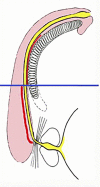Surgical treatment of bulbar urethral strictures: tips and tricks
- PMID: 31961622
- PMCID: PMC7239284
- DOI: 10.1590/S1677-5538.IBJU.2020.99.04
Surgical treatment of bulbar urethral strictures: tips and tricks
Abstract
The surgical treatment of bulbar urethral strictures is still one of the most challenging reconstructive surgery problems. Bulbar urethral strictures are usually categorized as traumatic and non-traumatic strictures depending on the aetiology. The traumatic strictures are caused by trauma and they determine disruption of the urethra with obliteration of the urethral lumen, ending with fibrotic gaps between the urethral ends. Differently, the non-traumatic urethral strictures are mainly caused by catheterization, instrumentation, and infection, or they can also be idiopathic. They are usually asso-ciated with spongiofibrosis of the segment of the urethra that has been involved. Worldwide, two different surgical approaches are currently adopted for bulbar urethral repair: transecting techniques with end-to-end anastomosis and non-transecting techniques followed by grafting. Traumatic obliterated strictures require transection of the urethra allowing complete removal of the fibrotic tissue that involves the urethral ends. Conversely, non-traumatic, non-obliterated urethral strictures require augmentation of the urethral plate using oral mucosa grafts. Nowadays, it is still difficult to choose the correct surgical management for non-obliterated bulbar stricture repair. Indeed, different surgical techniques have been proposed (pedicled flap vs free graft, dorsal vs ventral placement of the graft, non-transecting technique using or non-using free graft, etc.) but none emerged as the best solution since all techniques have showed similar success and complication rates. Consequently, the final choice is still based on surgeon's preferences and patient's characteristics. Within the current manuscript, we like to present some of our tips and tricks that we developed along our prolonged surgical experience on the treatment of bulbar urethral strictures. These might be of interest for surgeons that approach this complex surgery. Moreover, our suggestions want to be useful regardless the type of chosen technique being adaptable for different scenario.
Keywords: Anastomosis, Surgical; Surgical Procedures, Operative; Urethra.
Copyright® by the International Brazilian Journal of Urology.
Conflict of interest statement
None declared.
Figures








Comment in
-
In these difficult times of COVID-19, urologic research cannot stop: COVID-19 pandemic and reconstructive urology highlighted in International Brazilian Journal of Urology.Int Braz J Urol. 2020 Jul-Aug;46(4):496-498. doi: 10.1590/S1677-5538.IBJU.2020.04.01. Int Braz J Urol. 2020. PMID: 32374121 Free PMC article. No abstract available.
References
-
- 3. Martínez-Piñeiro JA, Cárcamo P, García Matres MJ, Martínez-Piñeiro L, Iglesias JR, Rodríguez Ledesma JM. Excision and anastomotic repair for urethral stricture disease: experience with 150 cases. Eur Urol. 1997;32:433-41. - PubMed
- Martínez-Piñeiro JA, Cárcamo P, García Matres MJ, Martínez-Piñeiro L, Iglesias JR, Rodríguez Ledesma JM. Excision and anastomotic repair for urethral stricture disease: experience with 150 cases. Eur Urol. 1997;32:433–441. - PubMed
-
- 4. Santucci RA, Mario LA, McAninch JW. Anastomotic urethroplasty for bulbar urethral stricture: analysis of 168 patients. J Urol. 2002;167:1715-9. - PubMed
- Santucci RA, Mario LA, McAninch JW. Anastomotic urethroplasty for bulbar urethral stricture: analysis of 168 patients. J Urol. 2002;167:1715–1719. - PubMed
-
- 5. Eltahawy EA, Virasoro R, Schlossberg SM, McCammon KA, Jordan GH. Long-term followup for excision and primary anastomosis for anterior urethral strictures. J Urol. 2007;177:1803-6. - PubMed
- Eltahawy EA, Virasoro R, Schlossberg SM, McCammon KA, Jordan GH. Long-term followup for excision and primary anastomosis for anterior urethral strictures. J Urol. 2007;177:1803–1806. - PubMed
Publication types
MeSH terms
LinkOut - more resources
Full Text Sources
Medical
